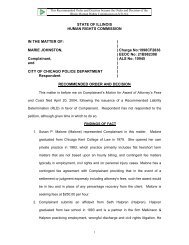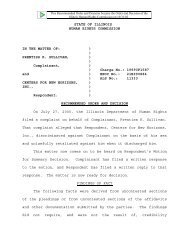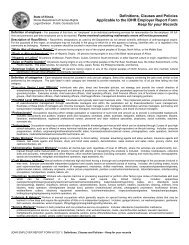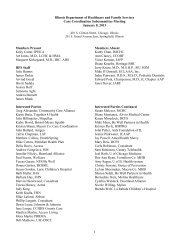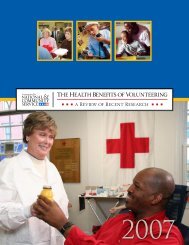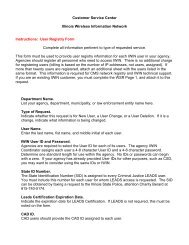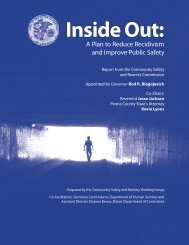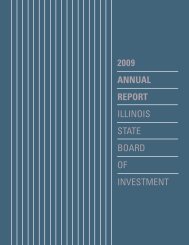Illinois Risk, Assets and Needs Assessment Task ... - State of Illinois
Illinois Risk, Assets and Needs Assessment Task ... - State of Illinois
Illinois Risk, Assets and Needs Assessment Task ... - State of Illinois
Create successful ePaper yourself
Turn your PDF publications into a flip-book with our unique Google optimized e-Paper software.
To:From:Re:<strong>Illinois</strong> <strong>Risk</strong>, <strong>Assets</strong> <strong>and</strong> <strong>Needs</strong> <strong>Assessment</strong> <strong>Task</strong> ForceVera Institute <strong>of</strong> Justice, Center on Sentencing <strong>and</strong> CorrectionsNational Information on Offender <strong>Assessment</strong>s, Part IIDate: May 27, 2010This memor<strong>and</strong>um provides an overview <strong>of</strong> current assessment instruments used in the adultcriminal justice system. 1 It also presents the results <strong>of</strong> a national survey conducted by the VeraInstitute <strong>of</strong> Justice <strong>of</strong> the use <strong>of</strong> assessment instruments by community supervision agencies <strong>and</strong>releasing authorities. The goal <strong>of</strong> the survey was to identify the most commonly used assessmenttools <strong>and</strong> to identify trends in how agencies are using the information collected by the tools.I. National Survey Results: Key FindingsOverall, over 60 community supervision agencies in 41 states reported using an actuarialassessment tool, suggesting that an overwhelming majority <strong>of</strong> corrections agencies nationwideroutinely utilize assessment tools to some degree. 2 The key findings from the survey include: <strong>Assessment</strong> is new. Many jurisdictions are relatively new to assessment: seventy percent<strong>of</strong> respondents implemented their assessment tools since 2000, with one third <strong>of</strong> thosehaving implemented since 2005. Less than 20 percent reported the use <strong>of</strong> assessmenttools in the 1990s or earlier. <strong>State</strong>-specific or state-modified tools are most common. Of the 41 states that responded tothis survey, twenty reported using a state-specific tool. 3 LSI-R is the most commonly used generic tool. Of the remaining 20 states, 16 <strong>of</strong> themreported using the LSI-R. Other commonly used tools are the COMPAS (three states) <strong>and</strong>the LS/CMI (three states). <strong>Risk</strong> <strong>and</strong> need are routinely assessed. A significant majority (82 percent) <strong>of</strong> respondentsreported assessing both risk <strong>and</strong> need, while just 18 percent reported that they assess onlyrisk. Releasing authorities reported assessing only risk at a greater rate than supervisionagencies. All respondents who use COMPAS report assessing both risk <strong>and</strong> need. Most– but not all – <strong>of</strong> those using LSI-R also assess both factors. Paroling authorities generally assess risk only. Despite being responsible for settingparole/post-release supervision conditions, nearly 40 percent <strong>of</strong> the releasing authoritiesassess only risk <strong>and</strong> not needs.1 Vera’s first memo explained the core principles underlying <strong>of</strong>fender assessments <strong>and</strong> described the various pointsin the criminal justice system at which assessments are commonly used. For a copy <strong>of</strong> the memo, contact MaggiePeck at Vera Institute: 212-376-3094 or mpeck@vera.org.2 Responses were received from 72 agencies (probation, parole, <strong>and</strong> releasing authorities) across 41 different states.3 Some <strong>of</strong> these state-specific tools were modified versions <strong>of</strong> the LSI-R, LS/CMI or Wisconsin Model.1
<strong>Assessment</strong> at pre-sentence stage. Nearly all probation agencies report that they conducttheir assessments in the pre-sentence phase. <strong>Assessment</strong> used to guide supervision levels. The most common use <strong>of</strong> the assessment isto guide supervision levels. <strong>Assessment</strong> results are also used to develop case plans, setcase loads <strong>and</strong> guide revocation decisions. Sharing results is common. Nearly all probation agencies share the results with thesentencing judge, <strong>and</strong> one jurisdiction even shares the results with the judge, districtattorney <strong>and</strong> defense attorney. Many respondents reported sharing the results withtreatment providers. Storage <strong>of</strong> results is nearly all electronic. While most reported storing the results <strong>of</strong> theassessments in an electronic database, only some are web-based (nearly all COMPASusers <strong>and</strong> some LSI-R users).II.Commonly Used <strong>Assessment</strong> InstrumentsDrawing upon findings from the national survey as well as literature on <strong>of</strong>fender assessments,this section presents a more detailed description <strong>of</strong> the tools most commonly used by states: theLSI-R, COMPAS <strong>and</strong> LS/CMI. 4 A chart comparing these tools is included in Appendix A.Included in Appendix B is a review <strong>of</strong> assessment tools compiled by the <strong>Illinois</strong> Collaborative onReentry’s Alternatives to Incarceration Workgroup, which includes a description <strong>of</strong> the LSI-R,COMPAS <strong>and</strong> several specialized tools.Level <strong>of</strong> Service Inventory-Revised (LSI-R)General Information. As indicated in our survey, the LSI-R is the most commonly used <strong>and</strong>researched generic assessment tool throughout the country. The LSI-R was developed byCanadian researchers Don Andrews <strong>and</strong> James Bonta, both <strong>of</strong> whom are widely recognized fortheir research on the risk, need <strong>and</strong> responsivity principles. 5 The tool is a robust predictor <strong>of</strong>recidivism across a range <strong>of</strong> correctional settings – corrections, probation <strong>and</strong> parole – <strong>and</strong>claims validity across age, gender, race <strong>and</strong> economic backgrounds. It assists correctionalpr<strong>of</strong>essionals in making decisions concerning the necessary levels <strong>of</strong> supervision <strong>and</strong> can alsoaid in decisions concerning sentencing, program or institutional classification, release frominstitutional custody, bail <strong>and</strong> security level classifications, <strong>and</strong> assesses treatment progress.Domains. The LSI-R assesses a range <strong>of</strong> risk <strong>and</strong> criminogenic needs factors through semistructuredinterviews with <strong>of</strong>fenders <strong>and</strong> other sources <strong>of</strong> data collection, including a self-reportsurvey. The tool consists <strong>of</strong> a 54-item scale comprised <strong>of</strong> the following ten subscales: priorcriminal history, education/employment, financial situation, family/marital relationships,accommodation, use <strong>of</strong> leisure time, companions, alcohol/drug use, emotional/mental health, <strong>and</strong>attitudes/orientation (see Appendix A for more details).4 The COMPAS <strong>and</strong> LS/CMI instruments are considered “fourth-generation instruments,” while the LSI-R isconsidered a “third-generation instrument.” A description <strong>of</strong> the generational differences among assessmentinstruments is included in the previous Vera Institute memo (National Overview <strong>of</strong> Offender <strong>Assessment</strong>s, Part I).5 Multi-Health Systems (MHS), Inc. is the proprietor <strong>of</strong> the LSI-R.2
The LSI-R also has a screening instrument called the LSI-R:SV (Screening Version), which isused when resource <strong>and</strong> time constraints prohibit the full assessment from being administered.The LSI-R:SV consists <strong>of</strong> eight <strong>of</strong> the 54 items contained in the complete instrument <strong>and</strong> coversfour risk factors: criminal history, criminal attitudes, criminal associates <strong>and</strong> antisocialpersonality patterns. The screening tool is a brief <strong>and</strong> inexpensive way to establish whether thefull LSI-R should be administered, <strong>and</strong> it is not intended as a st<strong>and</strong>-alone assessment instrument.Criticism. Although the LSI-R is a strong general predictor <strong>of</strong> recidivism across differentbackgrounds <strong>and</strong> settings, it has been criticized as not being a valid predictor for women. Criticsassert that the tool was validated on an all-male sample <strong>and</strong> does not include certain items thatmay be significant to female risk; for example, whether the <strong>of</strong>fender has children or has acriminal spouse. 6 However, more recent research suggests that the tool is a valid predictor <strong>of</strong> riskfor both males <strong>and</strong> females.Correctional Offender Management Pr<strong>of</strong>iling for Alternative Sanctions (COMPAS)General Information. The COMPAS assessment instrument was developed by NorthpointeInstitute for Public Management, Inc., a research <strong>and</strong> consulting firm based out <strong>of</strong> Michigan.COMPAS is a statistically based risk <strong>and</strong> needs assessment designed to assess risk <strong>and</strong>criminogenic needs factors in adult <strong>and</strong> youth correctional populations. While other riskassessment instruments provide a single risk score, the COMPAS provides separate riskestimates for violence, recidivism, failure to appear, <strong>and</strong> community failure. The COMPAS alsoprovides a “criminogenic <strong>and</strong> needs pr<strong>of</strong>ile” for the <strong>of</strong>fender, which provides information aboutthe <strong>of</strong>fender with respect to criminal history, needs assessment, criminal attitudes, socialenvironment, <strong>and</strong> social support.Domains. The COMPAS assessment includes a number <strong>of</strong> strength <strong>and</strong> protective factors,including job <strong>and</strong> educational skills, history <strong>of</strong> successful employment, adequate finances, safehousing, family bonds, social <strong>and</strong> emotional support, <strong>and</strong> noncriminal parents <strong>and</strong> friends. Insome states where COMPAS is used (e.g., Michigan), the assessment summary form includes asection for the practitioner to list an individual’s strengths.Criticism. Although research suggests that the instrument is gender-responsive for both men <strong>and</strong>women, the tool has demonstrated mixed results regarding ethnicity. A 2008 research studyfound weak results for predicting arrest outcomes for African-American men. 7 The resultsindicated a tendency to either over- or under-classify study participants depending on race <strong>and</strong>ethnicity. However, the study has several limitations, including a short outcome period (12months post-release) <strong>and</strong> a relatively small sample size. More recently, a study found that theCOMPAS recidivism models performed equally well for African-American <strong>and</strong> White men atpredicting arrest outcomes. 86 Holtfreter, K. & Cupp, R. (2007). Gender <strong>and</strong> <strong>Risk</strong> <strong>Assessment</strong>. Journal <strong>of</strong> Contemporary Criminal Justice, Vol.23, No. 4, 363-382.7 Fass, T., Heilbrun, K., DeMatteo, D., & Fretz, F. (2008). The LSI-R <strong>and</strong> the COMPAS: Validation Data on Two<strong>Risk</strong>-<strong>Needs</strong> Tools. Criminal Justice <strong>and</strong> Behavior, 38, 1095-1108.8 Brennen, T., Dieterich, W. & Ehret. (2009). Evaluating the Predictive Validity <strong>of</strong> the COMPAS <strong>Risk</strong> <strong>and</strong> <strong>Needs</strong><strong>Assessment</strong> System. Criminal Justice <strong>and</strong> Behavior, Vol. 36, No. 1, 21-403
Level <strong>of</strong> Service/Case Management Inventory (LS/CMI)General information. The LS/CMI system is a comprehensive assessment instrument thatassesses risk <strong>and</strong> criminogenic needs. Similar to COMPAS, it serves as a fully functional casemanagement tool. The LS/CMI was developed by the same researchers who developed the LSI-R <strong>and</strong> it is owned by the same company (Multi-Health Systems). It was created to reflect theexp<strong>and</strong>ing knowledge base about <strong>of</strong>fender risk assessment that has emerged since thedevelopment <strong>of</strong> the LSI-R.Domains. The instrument was updated to assist correctional pr<strong>of</strong>essionals with the exp<strong>and</strong>edduties required <strong>of</strong> them, namely the focus on behavior change through programmaticinterventions <strong>and</strong> referrals. The revision includes refining <strong>and</strong> combining the 54 LSI-R items into43 items. In addition, assessors can indicate areas <strong>of</strong> <strong>of</strong>fender strength, serving as protectivefactors.As indicated in Table 1, the LS/CMI is comprised <strong>of</strong> eleven sections. Section 1 produces the totalrisk/need score based on the 43-item assessment. Sections 2, 3 <strong>and</strong> 4 assess mitigating oraggravating factors that can affect risk <strong>and</strong> need levels indicated in the first section. Section 6documents a pr<strong>of</strong>essional or administrative override. The remaining sections deal exclusivelywith case management considerations, including assessing responsivity concerns.SectionTable 1: LSC/MI Section FunctionsContent1. General <strong>Risk</strong>/Need Factor Total <strong>Risk</strong>/Need Score2. Specific <strong>Risk</strong>/Need Factors3. Prison Experience/Institutional Factors4. Other Client Issues5. Special Responsivity Considerations6. <strong>Risk</strong>/Need Summary <strong>and</strong> Override7. <strong>Risk</strong>/Need Pr<strong>of</strong>ilePersonal problems with criminogenic potential (e.g., racistbehavior), history perpetrationCrucial institutional considerations including history <strong>of</strong>incarceration <strong>and</strong> barriers to releaseSupplementary psychological <strong>and</strong> physical health, financial,accommodation, <strong>and</strong> victimization itemsDominant responsivity considerations from clinical research <strong>and</strong>correctional opinionSummarizes risk/need scores <strong>and</strong> allows for overriding scorebasedrisk/need levelGraphically summarizes the Section 1 subcomponent <strong>and</strong> risk/needlevel scores8. Program/Placement Decision Record <strong>of</strong> major classification decisions (e.g., program placement9. Case Management Plan10. Progress Record11. Discharge SummaryLists criminogenic needs, non –criminogenic needs, <strong>and</strong> specialresponsivity considerationsLog <strong>of</strong> activities designed to measure change resulting from casemanagement strategiesSummarizes information useful if the <strong>of</strong>fender returns to custodyor community supervision4
Research <strong>and</strong> validation. Extensive scientific validation has been conducted on the LS/CMI’spredictive validity. A review <strong>of</strong> the literature suggests the LS/CMI as a valid <strong>and</strong> reliableassessment tool across a range <strong>of</strong> <strong>of</strong>fenders. Furthermore, a 2004 meta-analysis <strong>of</strong> the LS/CMIconcluded that the instrument is as predictive <strong>and</strong> reliable with females as it is with males. 9 Theresearchers also determined the instrument to be effective across a range <strong>of</strong> settings including,probation, probation, <strong>and</strong> prison/jail. 10III.Other <strong>Assessment</strong> ToolsOhio <strong>Risk</strong> <strong>Assessment</strong> System (ORAS)General information. In collaboration with the Ohio Department <strong>of</strong> Rehabilitation <strong>and</strong>Corrections, researchers at the University <strong>of</strong> Cincinnati (led by Dr. Ed Latessa) developed theOhio <strong>Risk</strong> <strong>Assessment</strong> System (ORAS), which assesses individuals at several points in thecriminal justice system. Ohio developed ORAS with two specific goals in mind: first, to promoteconsistent <strong>and</strong> objective assessment <strong>of</strong> risk throughout the criminal justice system; <strong>and</strong> second, toimprove communication <strong>and</strong> avoid duplication <strong>of</strong> information from one system point to the next.Tools <strong>and</strong> domains. Five assessment instruments were created: Pretrial <strong>Assessment</strong> Tool,Community Supervision Screening Tool, Community Supervision Tool, Prison Intake Tool, <strong>and</strong>Reentry Tool. The Pretrial <strong>Assessment</strong> Tool is designed to predict risk <strong>of</strong> failure to appear at a futurecourt date <strong>and</strong> risk <strong>of</strong> arrest. It consists <strong>of</strong> seven items from four domains: criminalhistory, employment, substance abuse, <strong>and</strong> residential stability. The Community Supervision Screening Tool identifies moderate- to high-risk <strong>of</strong>fenders inneed <strong>of</strong> the complete assessment instrument. It is a four item instrument designed toquickly identify low risk cases that do not need the full assessment. The Community Supervision Tool assists in the designation <strong>of</strong> supervision levels <strong>and</strong>guides case management for <strong>of</strong>fenders in the community. It consists <strong>of</strong> 35 items fromseven domains: criminal history, education, employment <strong>and</strong> finances, family <strong>and</strong> socialsupport, neighborhood problems, substance abuse, antisocial associations, <strong>and</strong> antisocialattitudes <strong>and</strong> behavioral problems. The Prison Intake Tool prioritizes prison treatment based on the likelihood <strong>of</strong>re<strong>of</strong>fending. It consists <strong>of</strong> 31 items from five domains: criminal history, education,employment, <strong>and</strong> finances, family <strong>and</strong> social support, substance abuse, <strong>and</strong> criminallifestyle. The Reentry Tool predicts the likelihood <strong>of</strong> recidivism <strong>and</strong> was designed to beadministered within six months <strong>of</strong> release. It consists <strong>of</strong> 20 items from three domains:criminal history, social bonds, <strong>and</strong> antisocial attitudes.9 Williams, K. , Andrews, D. , Bonta, J. , Wormith, J. , Guzzo, L. <strong>and</strong> Brews, A. , 2009-03-04 "The Level <strong>of</strong>Service/Case Management Inventory (LS/CMI): Reliability <strong>and</strong> Validity in Female Offenders" Paper presented atthe annual meeting <strong>of</strong> the American Psychology - Law Society, TBA, San Antonio, TX . 2010-03-11from http://www.allacademic.com/meta/p295679_index.html10 Ibid.5
Research <strong>and</strong> validation. The five tools were validated on the Ohio population. The results <strong>of</strong> thevalidation study indicate that the ORAS instruments performed as well, if not better, than boththe LSI-R <strong>and</strong> the Wisconsin <strong>Risk</strong>/Need instrument. The tools are in the public domain <strong>and</strong> areavailable in non-automated paper-only format from the University <strong>of</strong> Cincinnati.Arizona Suite <strong>of</strong> Tools: OST, MOST <strong>and</strong> FROSTGeneral information. In 2004, the Arizona Administrative Office <strong>of</strong> the Courts sought tost<strong>and</strong>ardize assessment procedures across its 15 state probation <strong>of</strong>fices <strong>and</strong> implement a uniformscreening instrument. The tools used by Arizona include the Modified Offender Screening Tool(MOST), the Offender Screening Tool (OST), <strong>and</strong> the Field Reassessment Offender ScreeningTool (FROST). The MOST is a pre-screening tool to filter out low risk <strong>of</strong>fenders. The OST is acomprehensive assessment <strong>and</strong> case planning tool, which is conducted on all medium or highrisk placements as identified by the MOST screening tool. The FROST is used for reassessment.Domains. These tools were developed by the Maricopa County Adult Probation Department,which decided to create its own tool after reviewing the performance <strong>of</strong> existing <strong>of</strong>fender risk<strong>and</strong> needs assessment tools. The OST collects information in 10 categories that are supported bythe research as predictors <strong>of</strong> an <strong>of</strong>fender's criminal behavior: physical health/medical,vocation/financial, education, family <strong>and</strong> social relationships, residence <strong>and</strong> neighborhood,alcohol, drug abuse, mental health, attitude, <strong>and</strong> criminal behavior. The items on the OSTinclude both static <strong>and</strong> dynamic criminogenic risk factors.<strong>Assessment</strong>s are used by the probation departments to determine appropriate supervision levels,guide development <strong>of</strong> case management strategies, <strong>and</strong> provide a mechanism to measure<strong>of</strong>fender progress. The MOST <strong>and</strong> OST are used by all probation departments in Arizona <strong>and</strong> bylocal probation <strong>of</strong>fices (h<strong>and</strong>ling misdemeanors) in Virginia.ConclusionAlmost every state uses an assessment tool at one or more points in the criminal justice system toassist in the better management <strong>of</strong> <strong>of</strong>fenders in institutions <strong>and</strong> in the community. This memodescribes the tools most commonly used across the country <strong>and</strong> broadly outlines their general use<strong>and</strong> function in the criminal justice system. It also provides an overview <strong>of</strong> the risk, need <strong>and</strong>protective factors <strong>and</strong> predictive validity <strong>of</strong> each tool. As described above, one <strong>of</strong> the mostsignificant challenges corrections agencies have faced is sharing critical information collectedfrom the assessment from one agency to the next. To address this issue, a growing number <strong>of</strong>states are developing statewide <strong>and</strong> st<strong>and</strong>ardized assessment systems that allow information tomore readily flow from one system point to the next. The development <strong>and</strong> implementation <strong>of</strong> anassessment system is a cornerstone <strong>of</strong> the Crime Reduction Act <strong>of</strong> 2009 <strong>and</strong> one <strong>of</strong> the mostpromising initiatives to improve public safety outcomes <strong>and</strong> reduce costs in <strong>Illinois</strong>.6
Appendix A:Chart <strong>of</strong> Common <strong>Assessment</strong> Tools
Appendix B:<strong>Illinois</strong> Collaborative on ReentryAlternatives to Incarceration WorkgroupChart on Offender <strong>Assessment</strong>s
Review <strong>of</strong> <strong>Assessment</strong> Instruments-Compiled for the ATI WorkgroupBy Nikki Vines, L.M.S.W., Doctoral student, Jane Addams College <strong>of</strong> Social WorkDescriptionStrengthsCautionsLSI-R (Level <strong>of</strong> Services Inventory Revised) Contains an interview <strong>and</strong> self report survey 54-item scale comprised <strong>of</strong> ten subscales: Prior Criminal History, Education/Employment,Financial Situation, Family/Marital Relationships, Accommodation, Use <strong>of</strong> LeisureTime, Companions, Alcohol/Drug Use, Emotional/Mental Health, <strong>and</strong>Attitudes/Orientation. Developed by Andrews <strong>and</strong> Bonta (1995). At the time <strong>of</strong> its development, it was seen as a more explicit, empirically based,<strong>and</strong> theory-guided approach <strong>and</strong> a broader selection <strong>of</strong> criminogenic factors. Inaddition, some <strong>of</strong> these factors were designed to be dynamically sensitive tochange. Feminist researchers object to use <strong>of</strong> the LSI-R due to:1) claims <strong>of</strong> gender neutrality based on social learning theory2) the interchange <strong>of</strong> needs <strong>and</strong> risks3) assertions <strong>of</strong> accurate classifications (Holtfreter & Cupp, 2007) “Accurately gauging recidivism risks for both sexes should incorporate salientbackground factors suggested by pathways research. Feminists contend thatmeasuring these actors in quantifiable terms, such as the yes/no format <strong>of</strong> LSI-Ritems, does not fully capture the diversity <strong>of</strong> circumstances shown to encouragedesistance from crime” (Holtfreter & Cupp, 2007).“Some research suggests that actuarial risk assessment instruments over classifyfemale <strong>of</strong>fenders, which results in more restrictive supervision” (Silver & Miller,2002 in Holtfreter & Cupp, 2007). Female <strong>of</strong>fenders are more likely to be overclassified than males (Holtfreter & Cupp, 2007). “Gendreau et al.’s (1996) meta-analysis is widely cited as support for the LSI-R’s gender neutrality, however the authors themselves recognize that theirfindings contributed little to the prediction <strong>of</strong> recidivism among females”(Hotfreter & Cupp, 2007). External validity is questionable as many studies involving women aimed toexamine predictive validity with unique populations. The operational definition <strong>of</strong> recidivism <strong>and</strong> time to recidivism are not consistentacross 11 studies <strong>of</strong> females. LSI-R does not measure objective poverty conditions. “Although there is sufficient evidence supporting the LSI-R’s predictive validitywith samples <strong>of</strong> males, the evidence is less clear for females” (Gendreau, Little& Goggin, 1996).1-5/26/2010
Review <strong>of</strong> <strong>Assessment</strong> Instruments-Compiled for the ATI WorkgroupBy Nikki Vines, L.M.S.W., Doctoral student, Jane Addams College <strong>of</strong> Social WorkWomen’s <strong>Risk</strong> <strong>Needs</strong> <strong>Assessment</strong> (WRNA) & Women's Supplemental <strong>Risk</strong> <strong>Needs</strong><strong>Assessment</strong> (WSRA) a.k.a Gender Responsiveness TrailerDescription Contains an interview <strong>and</strong> self report survey (Supplement is just self-reportpaper-<strong>and</strong>-pencil survey) Developed by members <strong>of</strong> the Women’s Issues Committee <strong>of</strong> the MO Dept. <strong>of</strong>Corrections in collaboration with researchers at the Univ. <strong>of</strong> Cincinnati. Measures gender-responsive needs <strong>of</strong> women <strong>of</strong>fenders. Comprised <strong>of</strong> multiple subscales, each asks questions which tap an underlyingdomain self-esteem, self-efficacy, parenting <strong>and</strong> relationship problems, <strong>and</strong>childhood <strong>and</strong> adult victimization. The supplement is designed to supplement existing dynamic risk/needsassessments such as the Level LSI-R <strong>and</strong> the Northpointe Compas.Strengths Informed by literature searches, focus groups with correctional administrators,treatment practitioners, line staff <strong>and</strong> women <strong>of</strong>fenders. The assessment items are measured through behavioral criteria, therebyrequiring few subjective judgments on the part <strong>of</strong> the practitioners orrespondents. <strong>Needs</strong> which were not unique to women (e.g., housing or accommodations,mental illness, financial circumstances, family support <strong>and</strong> others) werecontextualized in gender responsive terms. A number <strong>of</strong> items identify strengths (self efficacy, self-esteem, support fromothers, <strong>and</strong> educational assets). The scales <strong>and</strong> the final assessments were tested among three prison samples(Colorado, Minnesota, <strong>and</strong> Missouri), three probation samples (Maui,Minnesota, <strong>and</strong> Missouri) <strong>and</strong> two pre-release samples (Colorado <strong>and</strong>Missouri). Public domain (free)Cautions Tests <strong>of</strong> the two instruments in post-release settings were not as successful asthe tests for the probation <strong>and</strong> institutional sites. In all likelihood, the dynamicitems which were assessed while participants were incarcerated changed upontheir release. Results may have been better if the assessments wereadministered during the first months on parole.2-5/26/2010
Review <strong>of</strong> <strong>Assessment</strong> Instruments-Compiled for the ATI WorkgroupBy Nikki Vines, L.M.S.W., Doctoral student, Jane Addams College <strong>of</strong> Social WorkCOMPAS (Correctional Offender Management Pr<strong>of</strong>iling for Alternative Sanctions)Description COMPAS is an automated decision-support s<strong>of</strong>tware package that integrates risk<strong>and</strong> needs assessment with several other domains, including sentencingdecisions, treatment <strong>and</strong> case management, <strong>and</strong> recidivism outcomes.Strengths It allows users to track <strong>of</strong>fenders from intake to case closure to supportsequential case management monitoring, information feedback, <strong>and</strong> decisionmaking. In contrast to the LSI-R, which was designed primarily around a social learningexplanation, COMPAS reflects a broader theoretical base <strong>and</strong> include keyconstructs from low self-control theory, strain theory or social exclusion, socialcontrol theory (bonding), routine activities–opportunity theory, subcultural orsocial learning theories, <strong>and</strong> a strengths perspective. COMPAS includes a number <strong>of</strong> strength <strong>and</strong> protective factors including job <strong>and</strong>educational skills, history <strong>of</strong> successful employment, adequate finances, safehousing, family bonds, social <strong>and</strong> emotional support, noncriminal parents <strong>and</strong>friends. Integration <strong>of</strong> the risk <strong>and</strong> needs domain with separate domains <strong>of</strong> sentencingdecisions, institutional processing <strong>and</strong> placement decisions, case managementdecisions, treatments given (type <strong>and</strong> amount), <strong>and</strong> various outcomes (acrosstime). COMPAS uses “separate samples <strong>of</strong> males <strong>and</strong> females to develop genderspecificcalibrations <strong>of</strong> all risk <strong>and</strong> need factors <strong>and</strong> second by evaluating itspredictive <strong>and</strong> classification models on separate male <strong>and</strong> female samples”(Brennan, Dieterich & Erhart, 2009). No significant differences in alpha levelsbetween males <strong>and</strong> females, suggesting that the scales are equally reliable formen <strong>and</strong> women. A majority <strong>of</strong> the scales reach levels <strong>of</strong> internal consistency <strong>and</strong> predictivevalidity that are within generally acceptable ranges. Regarding internalconsistency, most <strong>of</strong> the scales have alpha coefficients equal to or greater than.70, with only three exceptions, <strong>and</strong> the latter were close to acceptable levels.Cautions There are mixed results regarding ethnicity. Brennan, Dieterich & Erhart (2009)found that the COMPAS recidivism models preformed equally well for AfricanAmerican <strong>and</strong> White men at predicting the arrest outcomes. There is only oneprevious study that examined the predictive accuracy <strong>of</strong> the COMPAS fordifferent ethnic groups-Fass, Heilbrun, DeMatteo, & Fretz (2008) which reportedmuch weaker results for African American men. However, the study’s results areunreliable, given the small overall sample size <strong>and</strong> extremely small effectivesample sizes for the ethnic groups. Studies to date are encouraging <strong>and</strong> suggest that the COMPAS risk models reachlevels <strong>of</strong> reliability, predictive validity, <strong>and</strong> generalizability that are at least equalto those <strong>of</strong> other major instruments in <strong>of</strong>fender risk assessment, howeverinstrument validation is in the early stages.3-5/26/2010
Review <strong>of</strong> <strong>Assessment</strong> Instruments-Compiled for the ATI WorkgroupBy Nikki Vines, L.M.S.W., Doctoral student, Jane Addams College <strong>of</strong> Social WorkTHE GAIN (GLOBAL ASSESSMENT OF INDIVIDUAL NEEDS)DescriptionStrengths The GAIN is a comprehensive biopsychosocial assessment tool. It is aprogressive <strong>and</strong> integrated series <strong>of</strong> measures <strong>and</strong> computer applicationsdesigned to support a number <strong>of</strong> treatment practices. It is used with bothadolescents <strong>and</strong> adults. It contains eight core sections (Background,Substance Use, Physical Health, <strong>Risk</strong> Behaviors <strong>and</strong> Disease Prevention,Mental <strong>and</strong> Emotional Health, Environment <strong>and</strong> Living Situation, Legal, <strong>and</strong>Vocational). Used in outpatient, intensive outpatient, partial hospitalization, methadone,short-term residential, long-term residential, therapeutic community, <strong>and</strong>correctional programs. It includes items designed to support most state <strong>and</strong> federal reportingrequirements, to compare to community samples from the NationalHousehold Survey on Drug Abuse (NHSDA), <strong>and</strong> to estimate changes in thecost to society (based on the work <strong>of</strong> Dr. Michael French <strong>and</strong> his colleagues) Can be administered by computer or with paper <strong>and</strong> pencil. The psychometrics <strong>of</strong> the GAIN <strong>and</strong> the scale norms have been establishedfor both adults <strong>and</strong> adolescents overall <strong>and</strong> by level <strong>of</strong> care (within age). Scale has high internal consistency <strong>and</strong> reliability.Cautions Norms by gender have not been generated (researchers are in the process <strong>of</strong>doing this) Researchers are also looking at variability in the degree <strong>of</strong> cooccurringmental disorders <strong>and</strong> involvement in family, school, work, welfare,<strong>and</strong> juvenile <strong>and</strong> criminal justice systems.4-5/26/2010
Review <strong>of</strong> <strong>Assessment</strong> Instruments-Compiled for the ATI WorkgroupBy Nikki Vines, L.M.S.W., Doctoral student, Jane Addams College <strong>of</strong> Social WorkOhio <strong>Risk</strong> <strong>Assessment</strong> System (ORAS)DescriptionStrengths Development <strong>of</strong> ORAS produced five assessment tools designed to predictthe likelihood <strong>of</strong> recidivism at different points in the criminal justiceprocess (The Pretrial <strong>Assessment</strong> Tool, The Community Supervision Tool,The Community Supervision Screening Tool, The Prison Intake Tool, <strong>and</strong>the Reentry Tool.) These tools not only are used to assign supervision levels, but are alsodesigned to assist case managers in targeting dynamic risk factors <strong>and</strong>identifying barriers to treatment. Overall, the results from the validation are favorable, indicating that eachtool was able to clearly distinguish between groups <strong>of</strong> <strong>of</strong>fenders withescalating rates <strong>of</strong> recidivism. Concurrent validity also was examined bycomparing the predictive power <strong>of</strong> each assessment tool to the LSI-R <strong>and</strong>the Wisconsin <strong>Risk</strong>/<strong>Needs</strong> instruments. These results revealed that theinstruments for the Ohio <strong>Risk</strong> <strong>Assessment</strong> System performed as well if notbetter than both <strong>of</strong> the other instruments. ORAS is similar to the LSI-R but is public domain (like the WRNA), sothe assessment is free to use.Cautions Further validation is needed. (follow up time in validation study involving1800 participants was only one year). The findings are preliminary-certain types <strong>of</strong> cases are underrepresented inthe population (e.g., sex <strong>of</strong>fenders, Hispanic <strong>of</strong>fenders, female <strong>of</strong>fenders).The underrepresentation in the population leads to small numbers <strong>of</strong> thesetypes <strong>of</strong> <strong>of</strong>fenders in the sample. Gender neutral5-5/26/2010
Review <strong>of</strong> <strong>Assessment</strong> Instruments-Compiled for the ATI WorkgroupBy Nikki Vines, L.M.S.W., Doctoral student, Jane Addams College <strong>of</strong> Social WorkDescriptionThe Service Planning Instrument (SPIn) A model for assessing risk, need <strong>and</strong> protective factors in adult populations. Itcan be used in probation, parole, re-entry <strong>and</strong> custodial settings where there is arequirement to assess risk <strong>of</strong> recidivism <strong>and</strong> identify service needs. The primary objective in using SPIn is helping case workers develop serviceplans for their criminal justice clients.Strengths Provides scoring that is helpful for classifying <strong>of</strong>fenders according to overallrisk level so that adequate supervision resources can be assigned. Provides capabilities to link assessment results in an immediate way to theprocess <strong>of</strong> individualized case planning <strong>and</strong> appropriate service provision. SPInhelps with case planning by identifying need areas that can be easily linked tointerventions <strong>and</strong> other services for adult <strong>of</strong>fenders. Incorporates the measurement <strong>of</strong> protective factors or strengths. Theassessment <strong>of</strong> protective factors focuses case plans to capitalize on strengths<strong>and</strong> helps develop resources for <strong>of</strong>fender success. Customization <strong>of</strong> the program is <strong>of</strong>feredCautions Compatible with Youth <strong>Assessment</strong> Screening Instrument (YASI) Is a web-based program, private domain (costly) Is a new assessment (2009)6-5/26/2010
Review <strong>of</strong> <strong>Assessment</strong> Instruments-Compiled for the ATI WorkgroupBy Nikki Vines, L.M.S.W., Doctoral student, Jane Addams College <strong>of</strong> Social WorkDescriptionThe Service Planning Instrument for Women (SPIn-W) The Service Planning Instrument for Women (SPIn-W) contains 100-itemsthat assess risk, need <strong>and</strong> protective factors that have demonstrated relevancefor increasing responsivity in case work with justice involved women. While, the content <strong>of</strong> SPIn-W overlaps with traditional risk/need assessment ingeneral populations <strong>of</strong> men <strong>and</strong> women, SPIn-W items related to child custody<strong>and</strong> parenting issues, domestic violence, mental health, social support, <strong>and</strong>community living. Items in assessment domains related to attitudes, aggression,interpersonal skills, <strong>and</strong> cognitive skills have been tailored to take into accounthow these areas <strong>of</strong> risk are manifested in female <strong>of</strong>fender populations.Strengths Was developed from research <strong>and</strong> field practice with criminal justice involvedwomen. Provides scoring that is helpful for classifying <strong>of</strong>fenders according tooverall risk level so that adequate supervision resources can be assigned.Same Strengths as SPIn: Provides capabilities to link assessment results in an immediate way to theprocess <strong>of</strong> individualized case planning <strong>and</strong> appropriate service provision. SPInhelps with case planning by identifying need areas that can be easily linked tointerventions <strong>and</strong> other services for adult <strong>of</strong>fenders. Incorporates the measurement <strong>of</strong> protective factors or strengths. Theassessment <strong>of</strong> protective factors focuses case plans to capitalize on strengths<strong>and</strong> helps develop resources for <strong>of</strong>fender success. Customization <strong>of</strong> the program is <strong>of</strong>feredCautions Compatible with Youth <strong>Assessment</strong> Screening Instrument (YASI)Same Cautions as SPIn: Is a web-based program, private domain (costly) Is a new assessment (2009)7-5/26/2010
Review <strong>of</strong> <strong>Assessment</strong> Instruments-Compiled for the ATI WorkgroupBy Nikki Vines, L.M.S.W., Doctoral student, Jane Addams College <strong>of</strong> Social WorkThe Wisconsin Department <strong>of</strong> Corrections <strong>Risk</strong> <strong>Assessment</strong> Instrumenta.k.a.Admission to Adult Field Caseload <strong>Risk</strong> Classification Instrumenta.k.a.DOC 502 <strong>Risk</strong> <strong>Assessment</strong> InstrumentDescription Is used not only to estimate risk probabilities for supervision purposes, but alsoto help determine staff workload <strong>and</strong> deployment.StrengthsCautions A revised version <strong>of</strong> the instrument is under development. 2009 validation study reveals over classification. A high percentage <strong>of</strong><strong>of</strong>fenders are classified as high risk, which is counter to the goal <strong>of</strong> riskclassification: to differentiate the population by risk <strong>and</strong> allocate resourcesaccordingly. The current risk score provides little differentiation <strong>of</strong> thepopulation, especially with the parole population, where 93% <strong>of</strong> <strong>of</strong>fenders areclassified as high risk. As a result <strong>of</strong> the 2009 validation study, the instrumentis under revision.8-5/26/2010



